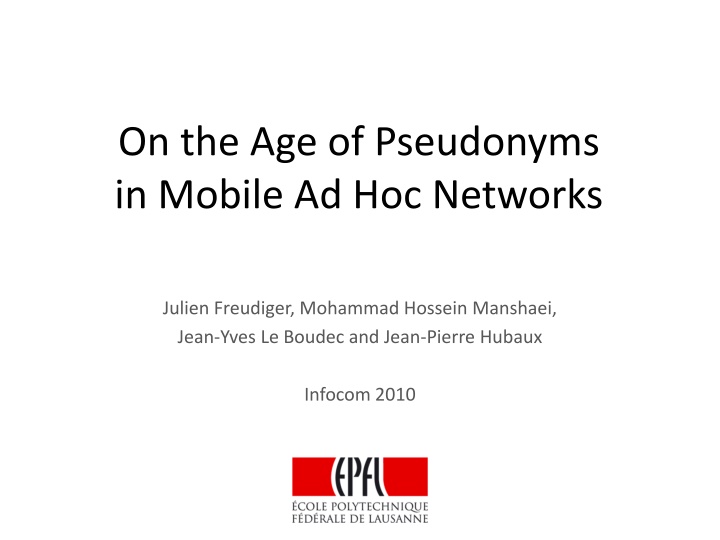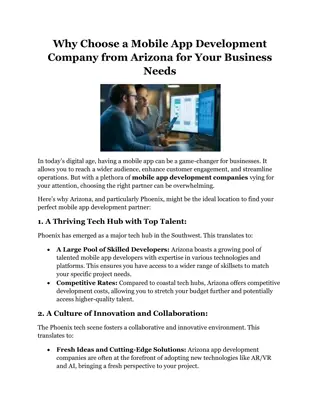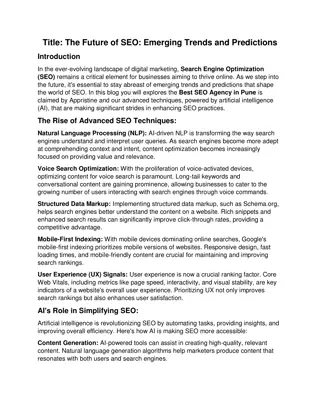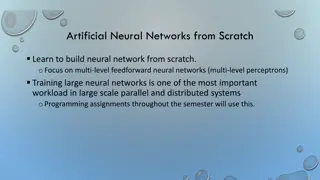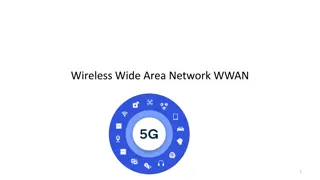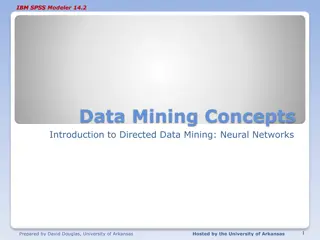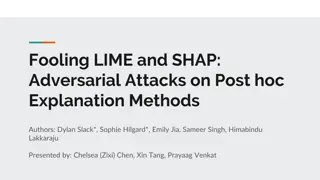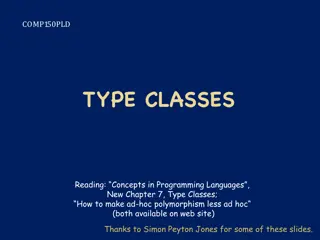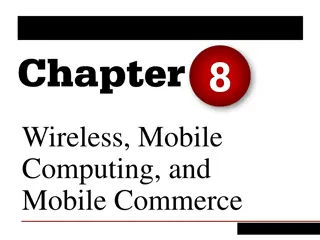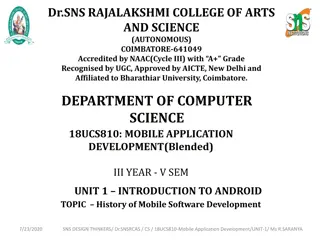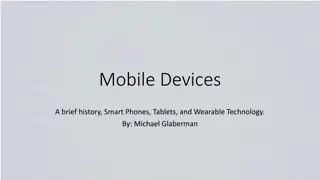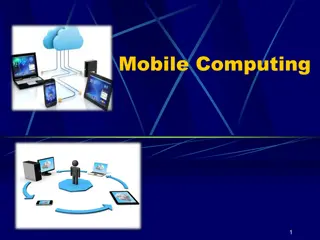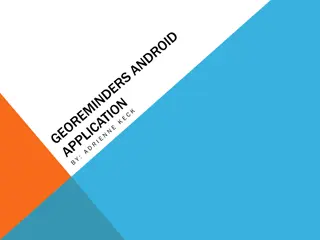Insights into Mobile Ad Hoc Networks and Location-Based Applications
Explore the intersection of mobile ad hoc networks, location-based applications, and context-based services in a hyper-connected world. Understand the implications of human movement patterns, privacy threats, and the significance of location as identity. Discover strategies for controlling location disclosure and enhancing location privacy through pseudonym age distribution analysis.
Download Presentation

Please find below an Image/Link to download the presentation.
The content on the website is provided AS IS for your information and personal use only. It may not be sold, licensed, or shared on other websites without obtaining consent from the author.If you encounter any issues during the download, it is possible that the publisher has removed the file from their server.
You are allowed to download the files provided on this website for personal or commercial use, subject to the condition that they are used lawfully. All files are the property of their respective owners.
The content on the website is provided AS IS for your information and personal use only. It may not be sold, licensed, or shared on other websites without obtaining consent from the author.
E N D
Presentation Transcript
On the Age of Pseudonyms in Mobile Ad Hoc Networks Julien Freudiger, Mohammad Hossein Manshaei, Jean-Yves Le Boudec and Jean-Pierre Hubaux Infocom 2010
Location-based Applications Share location Twitter Flickr Google search Foursquare Loopt Google Latitude Ovi Get Location Cellular networks GPS Wifi IP 2
Context-based Applications Sense neighborhood Ad hoc communications RFID Communicate Vehicular Networks Proximity-based Social Networks Opportunistic communications Delay-tolerant networks 3
Hyper-connected World Locality is one contextual information most useful when combined with others 4
Location Provides insight into human behavior Enables localized services Helps city planners 5 SPOTRANK by Skyhook wireless
You Are the City Understand urban construct through the interaction of its parts Petra Kempf, Architect and Urban Designer 6
Privacy Threat Human movement is highly predictable and follows simple reproducible patterns Visited locations reveal Personal activities Professional activities Social activities C. Song, Z. Qu, N. Blumm and A.-L.Barabasi. Limits of Predictability in Human Mobility. Science 2010 7
Its not where you are, it s where you have been Gary Gale, Yahoo 9
GOAL Control location disclosure 10
This Paper Consider Context-based applications Ad hoc wireless communications Mix zones to prevent tracking of users Contribution Measure achieved location privacy using the distribution of age of pseudonyms 11
Ad Hoc Networks (Peer-to-Peer Wireless Communications) 1 2 Identifier Pseudonym Message Signature + certificate 12
Assumptions N mobile nodes 1 WiFi/Bluetooth enabled Ad hoc communications 5 2 Certification authority (CA) 6 4 3 13
Threat: Tracking Global passive eavesdropper tracks location of mobile nodes 1 2 14
Solution: Mix Zones Spatial decorrelation: Remain silent Temporal decorrelation: Change pseudonym y? 1 1 x 2 2 Mix zone A. Beresford and F. Stajano. Mix Zones: user privacy in location aware services. Percom, 2004 M. Li et al. Swing and Swap: User-centric approaches towards maximizing location privacy . WPES, 2006 15
Gain and Cost Gain Tracking uncertainty of adversary (entropy) Depends on number of nodes in mix zone and trajectory Cost Obtain new pseudonym Update routing tables Silent period 16
Mix networks vs Mix zones Alice source Mix node Mix node Alice destination Bob Alice Mix node Mix network Mix Zones 17
The Problem Can we measure the location privacy achieved with a network of mix zones? 18
Outline 1. Age of Pseudonym: A Metric for Location Privacy 2. Dynamical System: Mean Field Equations 3. Analytical Results 4. Numerical Results 19
Age of Pseudonym Adversary can track nodes between mix zones Mix zone = confusion point TRACEABLE Mix zone 1 Mix zone 2 Age of Pseudonym Location Privacy Older age of pseudonym results in lower location privacy 20
Evolution of Age of Pseudonym 3 E3 E1 E2 t A 2 1 ( ) iZ t Age: t 2t 1t 3t 0 E3:Failure E1: Success E2 :Success 21
Outline 1. Age of Pseudonym: A Metric for Location Privacy 2. Dynamical System: Mean Field Equations 3. Analytical Results 4. Numerical Results 22
Mean Field Theory Replace interactions between nodes with average interaction M. Bena m and J.-Y. Le Boudec. A class of mean field interaction models for computer and communication systems. Performance Evaluation, 65(11-12):823 838, 2008 23
Goal Measure probability distribution of a certain state CDF of the age of pseudonym Mean field theory says CDF is known to satisfy ordinary differential equations when N goes to infinity 24
Model Parameters Communication model : Communication rate Mobility Model : Rate of meetings : Average number of nodes in meetings Cooperation model c(z): Probability of cooperation at age z 25
Mean Field Equations: Drift Process At each time step, the age of pseudonym is incremented with rate iu Z : z 0 ( ) iZ t F z = t 1t 26 26
Mean Field Equations: Jump Process (1) ju can successfully change its pseudonym ju Z 1: z 0 ( ) iZ t F x = ( ) ( )(1 1 c x q t ) ( , ) x t dx x z 1 { } 0 c(z): Probability of cooperation of node with age z q(t): Probability of finding at least one cooperative node : Rate of meetings t 1t 2t 27
Mean Field Equations: Jump Process (2) ku cannot find a cooperative partner ku Z 2: z z 0 ( ) iZ t F x z = ( )(1 c x ( )) q t ( , ) x t dx 2 z t 1t 2t 28
Mean Field Equations F t = + + 1 2 ( , ) 1, t = F t F z = F x = ( ) ( )(1 1 c x q t ) ( , ) x t dx x z 1 { } 0 F x z = ( )(1 c x ( )) q t ( , ) x t dx 2 z 29
Outline 1. Age of Pseudonym: A Metric for Location Privacy 2. Dynamical System: Mean Field Equations 3. Analytical Results 4. Numerical Results 30
Stationary mode (t goes to infinity) ( , ) F z t t = 0 Cooperation is a threshold function ( ) c z 1 0c z 31
Mean Field Equation df dz ( ) ( ) c z f z + ) ( f z = (1 ) ( q c z ) 0 = ( ) f z dz 1 0 32
Solution: PDF of the Age of Pseudonyms + + + ( 1) m z m 33
Outline 1. Age of Pseudonym: A Metric for Location Privacy 2. Dynamical System: Mean Field Equations 3. Analytical Results 4. Numerical Results 34
Gamma Cost of Pseudonym change = 5, =1, c0=1 Constant -- f(0) Exponential Exponential X Polynomial Result 1: High results in older pseudonym distribution because of second jump process 35
= 5, =1, c0=1 Theta Cooperation Threshold Result 2: High results in older pseudonym distribution because there is less cooperation. 36
= 1, =5, c0=1 Lambda Communication rate Result 3: High results in older pseudonym distribution because pseudonym ages faster. 37
= 1, =5, c0=1, =1 Average number of nodes in meeting Result 4: High N results in younger pseudonym distribution because it is easier to find cooperative nodes. 38
Model Validation Random walk model 10km X 10km Transmission range: 100 meters Run simulation until convergence 39
Conclusion Developed a framework to measure the distribution of age of pseudonyms Main result: Possible to design system with low distribution of age of pseudonym Obtained a fundamental building block of location-privacy-preserving systems lca.epfl.ch/privacy twitter.com/jfreudiger 40
